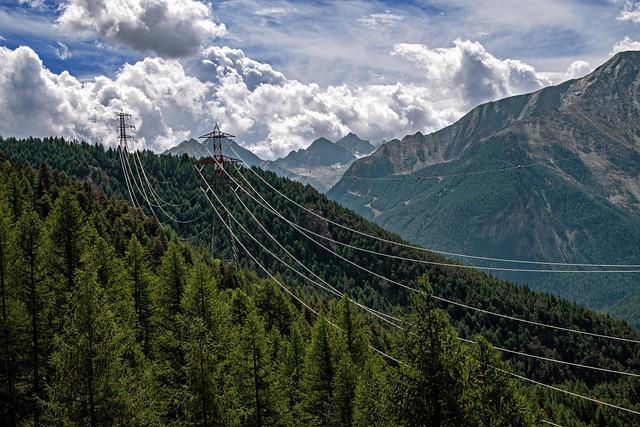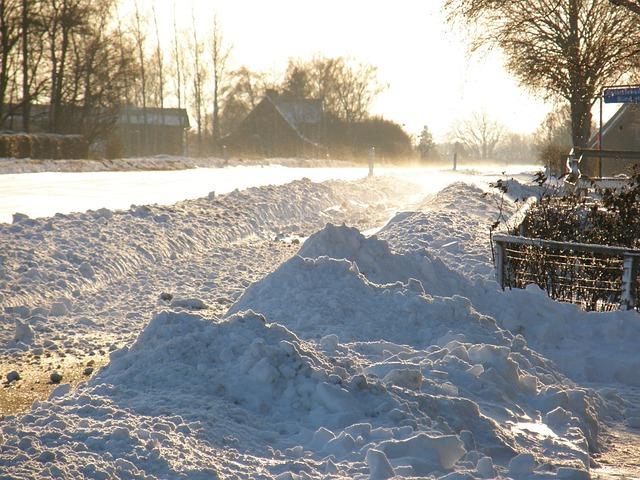Urban Heat Islands and Trees

Urban Heat Islands (UHIs) refer to areas within cities that experience significantly higher temperatures than their surrounding rural areas. These elevated temperatures can have a range of negative effects on human health, energy consumption, and the environment. One solution that is gaining traction in combating UHIs is the strategic planting of trees in urban areas. In this article, we will explore the relationship between urban heat islands and trees, and the potential benefits that increasing urban tree canopy coverage can have on mitigating the effects of UHIs.
Table of Contents
- Understanding Urban Heat Islands
- The Impact of Trees on Urban Heat Islands
- Strategies for Using Trees to Mitigate Urban Heat Islands
- Choosing the Right Tree Species for Urban Heat Island Mitigation
- Implementing Tree Planting Programs in Urban Areas
- Maximizing the Cooling Benefits of Trees in Urban Environments
- Q&A
- Conclusion
Understanding Urban Heat Islands
Urban heat islands are areas within urban environments where temperatures are significantly higher than surrounding rural areas. The heat absorbed by buildings and pavement during the day is released at night, creating a continuous cycle of high temperatures. Trees play a crucial role in mitigating the effects of urban heat islands by providing shade and cooling the surrounding air through evapotranspiration.
Planting trees in urban areas can help reduce the heat island effect by providing shade, increasing evapotranspiration, and lowering air temperatures. Trees also absorb carbon dioxide, a greenhouse gas that contributes to global warming, making them valuable allies in the fight against climate change. Additionally, trees can improve air quality by filtering out pollutants and particulate matter, creating a healthier and more sustainable urban environment for residents.
Incorporating a variety of tree species in urban planning can maximize the benefits of trees in combating the urban heat island effect. Different tree species have varying characteristics such as canopy size, leaf shape, and root systems, which can influence their cooling effects and overall resilience in urban environments. By strategically planting a mix of trees that provide shade, improve air quality, and enhance biodiversity, cities can create more resilient and sustainable urban landscapes.
| Benefits of Trees in Urban Environments |
|---|
| Reduction of air temperature |
| Improvement of air quality |
| Carbon sequestration |
The Impact of Trees on Urban Heat Islands
Urban heat islands are areas within cities that experience significantly higher temperatures than their surrounding rural areas. This phenomenon is mainly caused by the abundance of concrete, asphalt, and other heat-absorbing materials in urban environments. However, trees have proven to be a crucial factor in mitigating the effects of urban heat islands.
**Benefits of trees in reducing urban heat islands:**
- Shade provided by trees helps to lower surface temperatures in urban areas.
- Through a process called evapotranspiration, trees release water vapor, which cools the surrounding air.
- Trees also reduce energy consumption by providing natural cooling effects, thereby decreasing the demand for air conditioning in buildings.
| Tree Species | Temperature Reduction | Notable Features |
|---|---|---|
| Oak | Up to 10°F | Dense foliage |
| Maple | Up to 8°F | Colorful leaves in fall |
| Palm | Up to 15°F | Year-round greenery |
Strategies for Using Trees to Mitigate Urban Heat Islands
One effective way to combat the heat island effect in urban areas is by strategically utilizing trees to provide shade and lower temperatures. Trees offer a natural solution to this problem, as their canopy helps to create cooling microclimates and reduce the amount of heat absorbed and re-radiated by buildings and pavement. By implementing the following strategies, cities can maximize the cooling benefits of trees and improve the overall livability of urban spaces:
- Planting shade trees along streets and sidewalks to cool down the surrounding area and provide relief for pedestrians
- Creating green roofs and vertical gardens on buildings to reduce heat absorption and improve air quality
- Establishing urban forests and parks to increase green spaces and encourage biodiversity
By incorporating these strategies into urban planning and development, communities can effectively mitigate the urban heat island effect and create more sustainable and comfortable environments for residents. Trees not only help to cool down the city but also offer numerous other benefits, such as improving air quality, reducing energy costs, and enhancing the overall well-being of its inhabitants.
Choosing the Right Tree Species for Urban Heat Island Mitigation
Urban heat islands are areas within cities that experience significantly higher temperatures than their surrounding rural areas due to human activities. One effective way to mitigate the effects of urban heat islands is through the strategic planting of trees. Trees provide shade, absorb carbon dioxide, release oxygen, and lower temperatures through evapotranspiration.
When choosing tree species for urban heat island mitigation, it is crucial to consider several factors such as heat tolerance, water requirements, root system size, and maintenance needs. Some tree species that are well-suited for planting in urban areas include:
- London Plane Trees
- Japanese Zelkova Trees
- Red Maple Trees
| Tree Species | Heat Tolerance | Water Requirements |
|---|---|---|
| London Plane Trees | High | Moderate |
| Japanese Zelkova Trees | Medium | Low |
| Red Maple Trees | High | High |
Implementing Tree Planting Programs in Urban Areas
In urban areas, the phenomenon of urban heat islands poses a significant challenge to the environment and public health. To combat the heat trapping effects of urbanization, implementing tree planting programs has been identified as a sustainable solution. Trees play a crucial role in providing shade, reducing temperatures, and improving air quality in cities.
By strategically planting trees in urban areas, cities can mitigate the adverse impacts of urban heat islands and create a more livable environment for residents. Some key benefits of tree planting programs in urban areas include:
- Reduced energy consumption for cooling buildings
- Improved air quality through carbon sequestration
- Enhanced aesthetics and biodiversity
| City | Number of Trees Planted |
|---|---|
| New York City | 1 million |
| Los Angeles | 500,000 |
Maximizing the Cooling Benefits of Trees in Urban Environments
In urban environments, heat islands are a common issue caused by the excess heat retained by buildings and pavement. Trees play a crucial role in mitigating this heat by providing cooling benefits through shade and evapotranspiration. By strategically planting trees in urban areas, we can maximize their cooling effects and create more comfortable outdoor spaces for residents.
To maximize the cooling benefits of trees in urban environments, consider the following tips:
- Choose the right tree species that can thrive in urban conditions and provide ample shade.
- Plant trees in locations where they can shade buildings, streets, and parking lots to reduce heat absorption.
- Maintain trees regularly by pruning, watering, and fertilizing to ensure their health and optimal cooling benefits.
| Tree Species | Characteristics |
|---|---|
| Oak | Durable and provides dense shade |
| Maple | Fast-growing with vibrant foliage |
Q&A
Q: What are urban heat islands?
A: Urban heat islands are areas within cities that experience significantly higher temperatures than their rural surroundings due to human activities, such as energy consumption, and the construction of buildings and pavement that absorb and retain heat.
Q: How do trees help mitigate the effects of urban heat islands?
A: Trees play a crucial role in reducing urban heat islands by providing shade, blocking sunlight from heating up surfaces such as pavement, and releasing moisture through transpiration, which cools the surrounding air.
Q: What are some of the benefits of planting trees in urban areas?
A: Planting trees in urban areas can help lower temperatures, improve air quality, reduce energy consumption for cooling buildings, mitigate the effects of climate change, and enhance the overall quality of life for residents.
Q: How can city planners incorporate trees into urban development to combat urban heat islands?
A: City planners can incorporate trees into urban development by including green spaces, creating tree-lined streets, implementing urban forestry programs, and integrating tree planting into infrastructure projects. Collaboration between urban planners, arborists, and community members is essential for successful tree planting initiatives.
Q: Are there specific types of trees that are more effective in combating urban heat islands?
A: Trees with broad canopies, such as oak, maple, and sycamore trees, are particularly effective in providing shade and cooling urban areas. Native tree species that are well-adapted to local climate conditions are also recommended for their resilience and ability to thrive in urban environments.
Conclusion
In conclusion, the presence of trees in urban areas can help mitigate the effects of urban heat islands by providing shade, reducing air temperatures, and improving air quality. It is evident that incorporating trees into urban planning and development is crucial in combating the detrimental impacts of urban heat islands. By recognizing the importance of trees in mitigating heat stress and improving overall quality of life, cities can take proactive measures to create more sustainable and resilient urban environments. As we continue to address the challenges posed by urban heat islands, let us remember the vital role that trees play in shaping our cities and promoting healthier, more livable communities.
Simpsons Tree Services, Servicing Melbourne’s North Eastern Suburbs
Book a quote online at www.simpsonstrees.com.au


